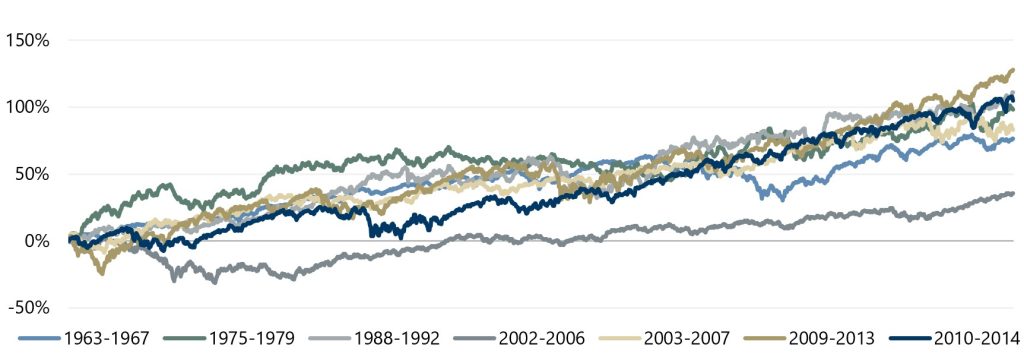Long-term equity returns after years like 2022 are attractive but volatile: Five-year periods after bear market drawdowns produced double-digit annualized returns in six out of seven instances since 1950. Annualized returns ranged from 6.28% to 17.93%. However, all five-year periods included additional double-digit drawdowns including three instances of drawdowns exceeding 20%.
Attractive but Volatile: Five-Year Returns After Bear Market Drawdowns


For investors whose primary concern is earning back last year’s losses, the recoveries after the drawdowns of 1962 and 2001 make for an interesting comparison. The recovery from the 1962 bear market drawdown was swift and steady, with the S&P 500® Index advancing to new all-time highs by mid-1963. Furthermore, the market climbed for more than three years without a drawdown of 10% or more – the first such pullback began in February 1966 and culminated in the 20.21% max drawdown for the five-year period. In contrast, after 2001, investors had to endure an additional stomach-wrenching loss of more than 33% in 2002 before the equity market began its recovery.
It is worth noting that there was also a significant disparity in bond market performance over the post-1962 and post-2001 recovery periods. For the five years after 1962, government bonds returned 2.47% annualized while corporate bonds returned just 0.30% annualized. Conversely, for the five years after 2001, government bonds returned 4.33% while corporate bonds returned 7.79%. Interest rate trends were a key driver of the different outcomes for the two periods. The yield on the 10-Year U.S. Treasury Note (the 10-Year) climbed from 3.85% at the end of 1962 to 5.70% at the end of 1967, but there was no such rising rate headwind for bonds in the early 2000s. The 10-Year yielded 5.05% at the end of 2001 and yielded 4.70% at the end of 2006.
Past performance is not indicative of future results. Data sources: Morningstar DirectSM and Ibbotson.
*For more information and access to additional insights from Gateway Investment Advisers, LLC, please visit www.gia.com/insights.


